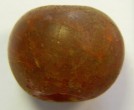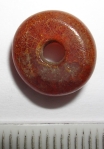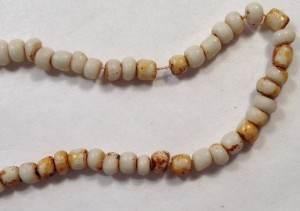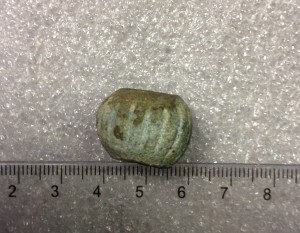Yes, you read that correctly: beads can change color. I’ve touched on this a little in previous posts, but let’s really look at the issue here.
I don’t mean that the color changes depending on the light, like I talked about last week. I mean that the color of the material actually changes based on environmental factors. This is mostly something to consider with archaeological beads, but it can also greatly affect modern beads as well.
Probably the issue of most concern to modern beaders is amber. Amber changes color when exposed to the air or heat. When amber is exposed to air, it becomes a much darker color (often a deep red). When it is exposed to heat, it becomes darker and also more translucent. The translucency depends on the amount of bubbles in the amber. The more amber is heated, the more the bubbles evaporate and the clearer the amber becomes.
This means that if you have an amber necklace purchased by your great-grandmother, it probably isn’t the same color now as it was when she purchased it. It also means that any amber beads you own will likely change color over time. It probably won’t be terribly drastic (unless you heat it), but it would change.
Glass can change color over time due to staining. I’ve seen a lot of beads form coastal regions with various seaweed-like patterns on them or other color changes due to salt water. Glass can corrode over time and become more opaque and a lighter color than it had been in the past. Faience also corrodes over time from bright turquoise to a very chalky light blue or green.
Stones will change color depending on exposure to heat, which is one way to make a red agate into carnelian. Amethyst becomes a bit clearer and lighter, even turning into a yellow citrine. Aquamarine becomes more blue, while ruby becomes more red. Sapphire becomes more intensely blue. But that doesn’t mean you should go putting your jewelry in your oven for a bit – there are certain procedures for it, and you don’t want to risk damaging your jewelry. (If you do go stick your jewelry in the oven, I am not at all responsible for the results!)
The difficulty in archaeological research is that it becomes very difficult to tell whether the change in color was intentional. For stones subjected to heating, that could well be an intentional part of the manufacturing process or it could be from intense exposure to heat in, say, a house fire. The same goes for amber. Faience and glass are a bit easier to tell, because it’s usually very difficult to get those effects otherwise, but it was possible to etch designs into glass using certain chemicals. Theoretically, a person might do that to the entire bead for artistic effect (or just to see what happens). So the question becomes about intent. Is that the intended color or not?
This gets even more difficult when we consider the fact that many people may have owned the same beads, and had different intents while owning them. One person may intentionally keep their amber opaque, but if they sell it to someone else years later, that person might heat the amber to clear it up a bit and darken the color.
In the end, color is incredibly complex (and I haven’t even talked about the differences in color perception). But if we try to have at least some type of system that we can explain to others so that they can use our data in their research, then we can start to look for patterns that can lead us to some interesting answers (and questions).






Why would my bloodstone bracelet that i wear daily be changing colors? This bracelet is what i wear daily to calm and ground me
Hello Janet,
Apologies for the delay, I was trying to find any source that described bloodstone changing color for any reason other than changes in lighting (such as body temperature). I haven’t found anything, so I would say that it’s likely due to changes in the light in which you’re seeing the bracelet. The varied color of the stone will make it appear differently at different times (a bit like opals), so that probably affects the color as well. Does that help?